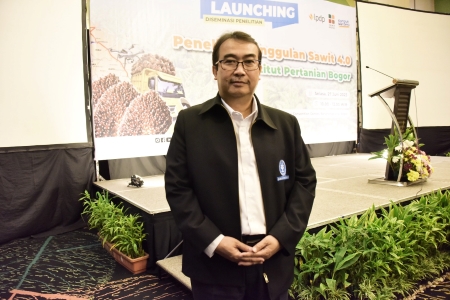IPB University Launched OPTIMAL-IPB, Palm Oil Innovation 4.0 Based on Deep Learning Models

IPB University launched an innovation in the field of oil palm called 'Oil Palm Identification Based on Machine Learning'-IPB (OPTIMAL-IPB). This innovation is a mapping model designed to be able to detect oil palm objects on high-resolution satellite imagery based on deep learning models. OPTIMAL-IPB received research funding from the Education Fund Management Institute (LPDP), Ministry of Finance of the Republic of Indonesia.
“Oil palm is a leading commodity which is an important source of foreign exchange for Indonesia. Until now, Indonesia is still the world's largest producer of palm oil," said Prof Ernan Rustiadi as the innovator of OPTIMAL-IPB during the Launching of IPB's Superior Research Results: Oil Palm 4.0 which was held by the Directorate of Research and Innovation of IPB University at the IPB International Convention Center, Bogor (27/6/2023).
Prof Ernan continued, with competitive palm oil productivity and prices, oil palm plants are not only cultivated by large companies, but also by the community. Currently the area of smallholder oil palm plantations has reached 40 percent of the total area of national oil palm plantations.
However, he said, social and environmental issues still threaten the competitiveness of Indonesian palm oil products in the world market. Large palm oil producing companies are gradually starting to apply the Indonesian Sustainable Palm Oil System (ISPO) or Roundtable on Sustainable Palm Oil (RSPO) standards to improve their plantation governance.
“However, this is still difficult to implement in smallholder oil palm plantations with a large number of small-scale farmers. Therefore, improving the governance of smallholder oil palm plantations is still a big challenge for Indonesia," he added.
According to him, the main problem of smallholder oil palm plantations is their low productivity. This is caused by cultivation patterns that have not been optimal, limited agricultural inputs, varied plant varieties, relatively old plant ages, planting on unsuitable land and so on.
The government has attempted to design various programs to improve the governance of smallholder oil palm plantations. However, implementation has been slow due to the absence of a complete and accurate data base regarding the distribution of smallholder oil palm plantations. Because of this, Prof Ernan emphasized that "The spatial database of smallholder oil palm plantations is the key to ensuring that the implemented program is not misdirected, namely not given to smallholder oil palm plantations in forest areas, protected areas or lands that are not suitable."
Moreover, the mapping of smallholder oil palm plantations is a challenge in itself because of their characteristics, which are on average small in size, scattered and fragmented. The shape of the garden plots is also irregular, sometimes on remote or isolated land and mixed with other agricultural commodities.
“The currently used area or polygon-based mapping technologies are not capable of capturing features like this. Because of that, OPTIMAL-IPB was developed as an object-based mapping model, in this case, stands of oil palm trees. This innovation is able to detect oil palm objects in high-resolution satellite imagery based on deep learning models," explained Prof Ernan.
High-resolution imagery is used because it is relatively freely available on various platforms such as Google and Microsoft, although the challenge is that the size of the object that must be detected is much smaller than the object in a regular photo or drone photo.
"OPTIMAL-IPB is designed to have advantages in detecting small objects in the form of oil palm plants even in narrow locations, scattered and mixed with other plant objects. The results of the detection of oil palm plants are then used as the basis for delineating smallholder oil palm plantations," he continued.
The OPTIMAL-IPB model has been used to map the distribution of smallholder oil palm plantations in Jambi Province. This map is produced through a fast, accurate, cheap, easy and standardized process because it has been developed in the form of an easy-to-use application.
"In the future it is hoped that OPTIMAL-IPB can be utilized to map smallholder oil palm plantations throughout Indonesia and can be developed further to estimate age, production and productivity," hoped Prof Ernan. (*/Rz) (IAAS/SHY)



